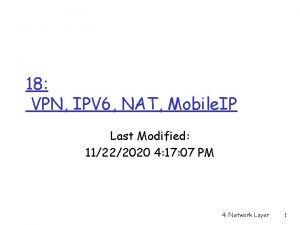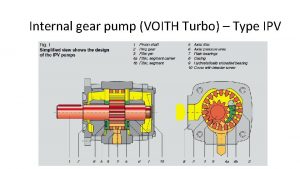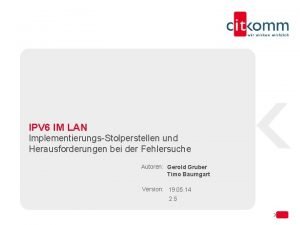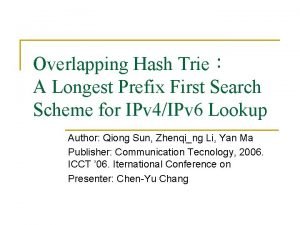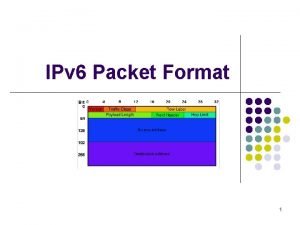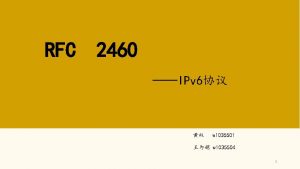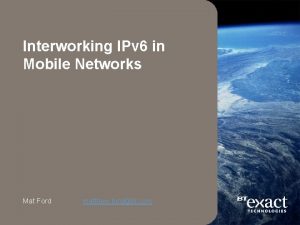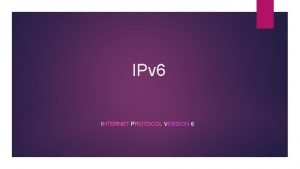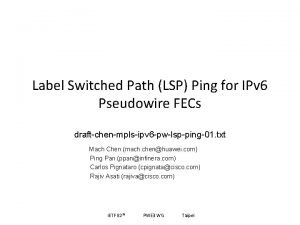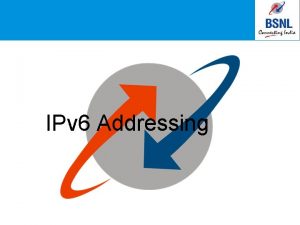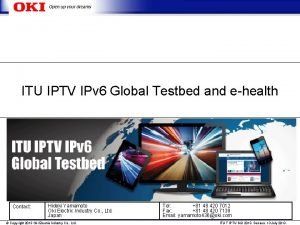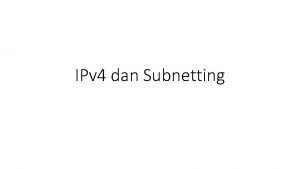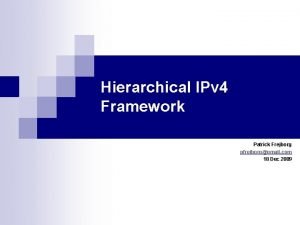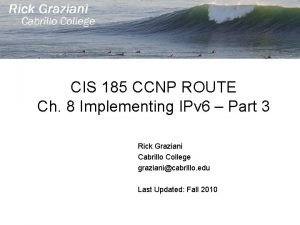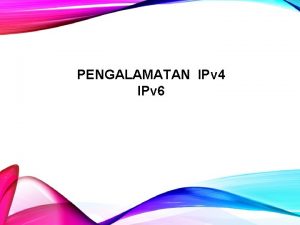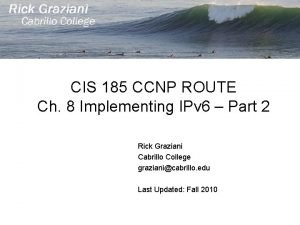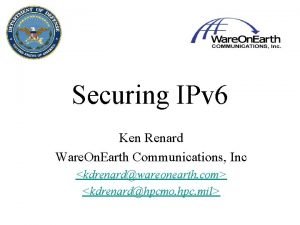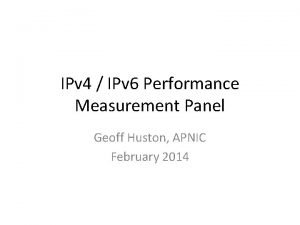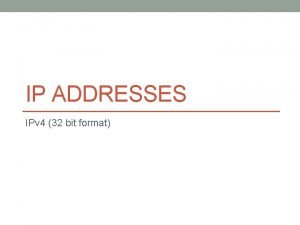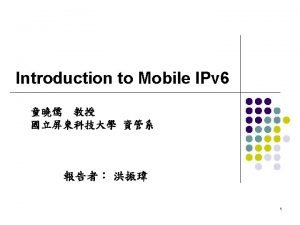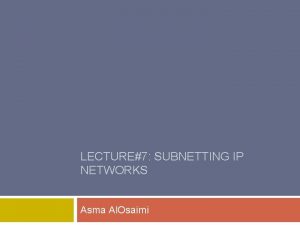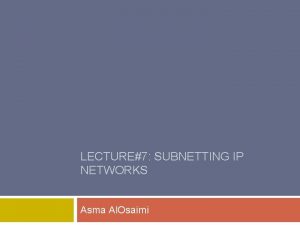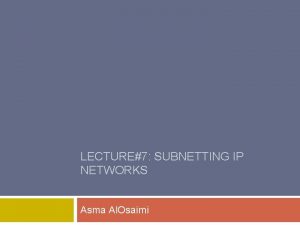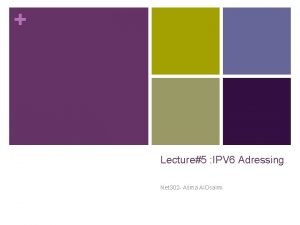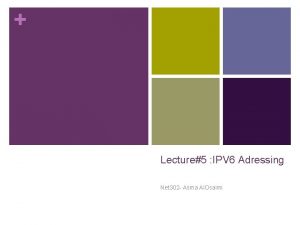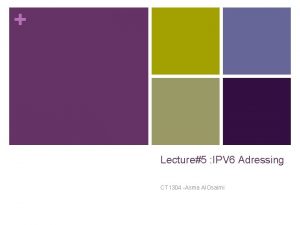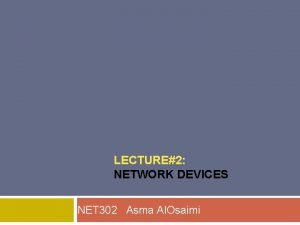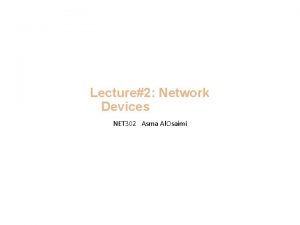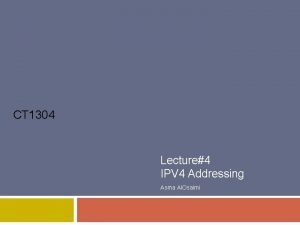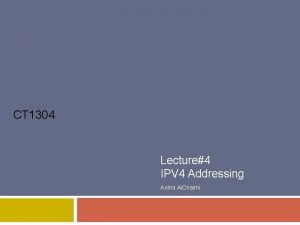LECTURE5 IPV 6 ADDRESSING Asma Al Osaimi Topics







































- Slides: 39

LECTURE#5 IPV 6 ADDRESSING Asma Al. Osaimi

Topics IPv 4 Issues IPv 6 Address Representation IPv 6 Types

IPv 4 Issues The Need for IPv 6 § IPv 6 is designed to be the successor to IPv 4. § Depletion of IPv 4 address space has been the motivating factor for moving to IPv 6. § Projections show that all five RIRs will run out of IPv 4 addresses between 2015 and 2020. § With an increasing Internet population, a limited IPv 4 address space, issues with NAT and an Internet of things, the time has come to begin the transition to IPv 6! § IPv 4 has a theoretical maximum of 4. 3 billion addresses, plus private addresses in combination with NAT. § IPv 6 larger 128 -bit address space provides for 340 undecillion addresses. § IPv 6 fixes the limitations of IPv 4 and includes additional enhancements, such as ICMPv 6.

IPv 4 Issues IPv 4 and IPv 6 Coexistence The migration techniques can be divided into three categories: Dual-stack, Tunnelling, and Translation. Dual-stack: Allows IPv 4 and IPv 6 to coexist on the same network. Devices run both IPv 4 and IPv 6 protocol stacks simultaneously.

IPv 4 Issues IPv 4 and IPv 6 Coexistence (cont. ) Tunnelling: A method of transporting an IPv 6 packet over an IPv 4 network. The IPv 6 packet is encapsulated inside an IPv 4 packet.

IPv 4 Issues IPv 4 and IPv 6 Coexistence (cont. ) Translation: The Network Address Translation 64 (NAT 64) allows IPv 6 -enabled devices to communicate with IPv 4 -enabled devices using a translation technique similar to NAT for IPv 4. An IPv 6 packet is translated to an IPv 4 packet, and vice versa.

IPv 6 Addressing Hexadecimal Number System Hexadecimal is a base sixteen system. Base 16 numbering system uses the numbers 0 to 9 and the letters A to F. Four bits (half of a byte) can be represented with a single hexadecimal value.

IPv 6 Addressing IPv 6 Address Representation 128 bits in length and written as a string of hexadecimal values In IPv 6, 4 bits represents a single hexadecimal digit, 32 hexadecimal value = IPv 6 address � 2001: 0 DB 8: 0000: 1111: 0000: 0200 � FE 80: 0000: 0123: 4567: 89 AB: CDEF Hextet used to refer to a segment of 16 bits or four hexadecimals Can be written in either lowercase or uppercase 4 hexadecimal digit s= 16 binary digits

IPv 6 Addressing IPv 6 Address Representation(cont. ) Example #1 Example #2

Types of IPv 6 Addresses IPv 6 Prefix Length IPv 6 does not use the dotted-decimal subnet mask notation Prefix length indicates the network portion of an IPv 6 address using the following format: § § § IPv 6 address/prefix length Prefix length can range from 0 to 128 Typical prefix length is /64

Types of IPv 6 Addresses IPv 6 Address Types There are three types of IPv 6 addresses: § Unicast § § Multicast Anycast. Note: IPv 6 does not have broadcast addresses.

Types of IPv 6 Addresses IPv 6 Unicast Addresses Unicast § § Uniquely identifies an interface on an IPv 6 -enabled device. A packet sent to a unicast address is received by the interface that is assigned that address.

Types of IPv 6 Addresses IPv 6 Unicast Addresses (cont. )

Types of IPv 6 Addresses IPv 6 Unicast Addresses (cont. ) Global Unicast § § Similar to a public IPv 4 address Globally unique Internet routable addresses Can be configured statically or assigned dynamically Link-local § § Used to communicate with other devices on the same local link Confined to a single link; not routable beyond the link

Types of IPv 6 Addresses IPv 6 Unicast Addresses (cont. ) Loopback § § § Used by a host to send a packet to itself and cannot be assigned to a physical interface. Ping an IPv 6 loopback address to test the configuration of TCP/IP on the local host. All-0 s except for the last bit, represented as : : 1/128 or just : : 1. Unspecified Address § § § All-0’s address represented as : : /128 or just : : Cannot be assigned to an interface and is only used as a source address. An unspecified address is used as a source address when the device does not yet have a permanent IPv 6 address or when the source of the packet is irrelevant to the destination.

Types of IPv 6 Addresses IPv 6 Unicast Addresses (cont. ) Unique Local § § § Similar to private addresses for IPv 4. Used for local addressing within a site or between a limited number of sites. In the range of FC 00: : /7 to FDFF: : /7. IPv 4 Embedded (not covered in this course) § Used to help transition from IPv 4 to IPv 6.

Types of IPv 6 Addresses IPv 6 Link-Local Unicast Addresses Every IPv 6 -enabled network interface is REQUIRED to have a linklocal address Enables a device to communicate with other IPv 6 -enabled devices on the same link and only on that link (subnet) FE 80: : /10 range, first 10 bits are 1111 1110 10 xx xxxx 1111 1110 1000 0000 (FE 80) - 1111 1110 1011 1111 (FEBF)

Types of IPv 6 Addresses IPv 6 Link-Local Unicast Addresses (cont. ) Packets with a source or destination link-local address cannot be routed beyond the link from where the packet originated.

IPv 6 Unicast Addresses Structure of an IPv 6 Global Unicast Address IPv 6 global unicast addresses are globally unique and routable on the IPv 6 Internet Equivalent to public IPv 4 addresses ICANN allocates IPv 6 address blocks to the five RIRs Currently, only global unicast addresses with the first three bits of 001 or 2000: : /3 are being assigned

IPv 6 Unicast Addresses Structure of an IPv 6 Global Unicast Address (cont. ) A global unicast address has three parts: Global Routing Prefix, Subnet ID, and Interface ID. § Global Routing Prefix is the prefix or network portion of the address assigned by the provider, such as an ISP, to a customer or site, currently, RIR’s assign a /48 global routing prefix to customers. § 2001: 0 DB 8: ACAD: : /48 has a prefix that indicates that the first 48 bits (2001: 0 DB 8: ACAD) is the prefix or network portion.

IPv 6 Unicast Addresses Structure of an IPv 6 Global Unicast Address (cont. ) Subnet ID is used by an organization to identify subnets within its site Interface ID § § Equivalent to the host portion of an IPv 4 address. Used because a single host may have multiple interfaces, each having one or more IPv 6 addresses.

IPv 6 Unicast Addresses Static Configuration of a Global Unicast Address

IPv 6 Unicast Addresses Static Configuration of an IPv 6 Global Unicast Address (cont. ) Windows IPv 6 Setup

IPv 6 Unicast Addresses EUI-64 Process or Randomly Generated EUI-64 Process § Uses a client’s 48 -bit Ethernet MAC address and inserts another 16 bits in the middle of the 46 -bit MAC address to create a 64 -bit Interface ID. § Advantage is that the Ethernet MAC address can be used to determine the interface; is easily tracked. EUI-64 Interface ID is represented in binary and comprises three parts: § 24 -bit OUI from the client MAC address, but the 7 th bit (the Universally/Locally bit) is reversed (0 becomes a 1). § Inserted as a 16 -bit value FFFE. § 24 -bit device identifier from the client MAC address.

IPv 6 Unicast Addresses EUI-64 Process or Randomly Generated (cont. )

IPv 6 Unicast Addresses EUI-64 Process or Randomly Generated (cont. )

IPv 6 Unicast Addresses EUI-64 Process or Randomly Generated (cont. ) Randomly Generated Interface IDs § Depending upon the operating system, a device can use a randomly generated Interface ID instead of using the MAC address and the EUI 64 process. § Beginning with Windows Vista, Windows uses a randomly generated Interface ID instead of one created with EUI-64. § Windows XP (and previous Windows operating systems) used EUI-64.

IPv 6 Unicast Addresses Dynamic Link-local Addresses Link-Local Address § After a global unicast address is assigned to an interface, an IPv 6 enabled device automatically generates its link-local address. § Must have a link-local address that enables a device to communicate with other IPv 6 -enabled devices on the same subnet. § Uses the link-local address of the local router for its default gateway IPv 6 address. § Routers exchange dynamic routing protocol messages using linklocal addresses. § Routers’ routing tables use the link-local address to identify the nexthop router when forwarding IPv 6 packets.

IPv 6 Unicast Addresses Dynamic Link-local Addresses (cont. ) Dynamically Assigned The link-local address is dynamically created using the FE 80: : /10 prefix and the Interface ID.

IPv 6 Unicast Addresses Static Link-local Addresses Configuring Link-local

IPv 6 Unicast Addresses Static Link-local Addresses (cont. ) Configuring Link-local

IPv 6 Global Unicast Addresses Verifying IPv 6 Address Configuration Each interface has two IPv 6 addresses - 1. 2. global unicast address that was configured one that begins with FE 80 is automatically added as a link-local unicast address

IPv 6 Global Unicast Addresses Verifying IPv 6 Address Configuration (cont. )

IPv 6 Multicast Addresses Assigned IPv 6 Multicast Addresses IPv 6 multicast addresses have the prefix FF 00: : /8 There are two types of IPv 6 multicast addresses: § § Assigned multicast Solicited node multicast

IPv 6 Multicast Addresses Assigned IPv 6 Multicast Addresses (cont. ) Two common IPv 6 assigned multicast groups include: § FF 02: : 1 All-nodes multicast group – § § § All IPv 6 -enabled devices join Same effect as an IPv 4 broadcast address FF 02: : 2 All-routers multicast group § § § All IPv 6 routers join A router becomes a member of this group when it is enabled as an IPv 6 router with the ipv 6 unicastrouting global configuration mode command. A packet sent to this group is received and processed by all IPv 6 routers on the link or network.

IPv 6 Multicast Addresses Assigned IPv 6 Multicast Addresses (cont. )

IPv 6 Multicast Addresses Solicited Node IPv 6 Multicast Addresses § Similar to the all-nodes multicast address, matches only the last 24 bits of the IPv 6 global unicast address of a device § Automatically created when the global unicast or link-local unicast addresses are assigned § Created by combining a special FF 02: 0: 0: 0: FF 00: : /104 prefix with the right-most 24 bits of its unicast address

IPv 6 Multicast Addresses Solicited Node IPv 6 Multicast Addresses (cont. ) The solicited node multicast address consists of two parts: FF 02: 0: 0: 0: FF 00: : /104 multicast prefix – First 104 bits of the all solicited node multicast address Least significant 24 -bits – Copied from the rightmost 24 bits of the global unicast or link-local unicast address of the device

Recourses Cisco Networking Academy program , Introduction to Networks
 Flat addressing vs hierarchical addressing
Flat addressing vs hierarchical addressing Wwwin.cisco.com
Wwwin.cisco.com Ipv vpn
Ipv vpn Ipv 4 terdiri dari... *
Ipv 4 terdiri dari... * Vaccination dose
Vaccination dose Fa voith
Fa voith Ipv format
Ipv format Ipv v4
Ipv v4 Rpv ecommerce
Rpv ecommerce Ipv
Ipv Modelo de ipv en cuba
Modelo de ipv en cuba Ipv erfahrungen
Ipv erfahrungen Hash trie
Hash trie Ipv format
Ipv format 1035504
1035504 Bt smar
Bt smar Ipv protocol
Ipv protocol Ipv allianz
Ipv allianz ۰میکنی
۰میکنی Ipvچیست
Ipvچیست Ipv 6
Ipv 6 Test ipv que mide
Test ipv que mide Lsp ping
Lsp ping Ipv header
Ipv header Apa itu iptv
Apa itu iptv Ipv 4 terdiri dari...
Ipv 4 terdiri dari... Polio ddt vergiftung
Polio ddt vergiftung Ipv 4 terdiri dari... *
Ipv 4 terdiri dari... * Ipv foo
Ipv foo Ipv route
Ipv route Ipv meaning
Ipv meaning Ipv format
Ipv format Route-map ipv
Route-map ipv Ipv meaning
Ipv meaning Ipv streaming
Ipv streaming Google analz
Google analz Ipv 4 terdiri dari... *
Ipv 4 terdiri dari... * Ipv format
Ipv format Ipv format
Ipv format Ipv route
Ipv route


